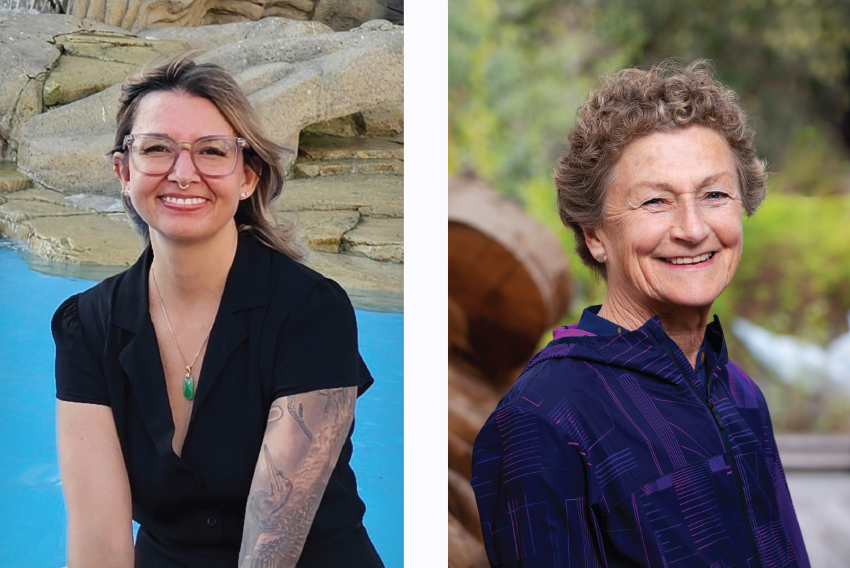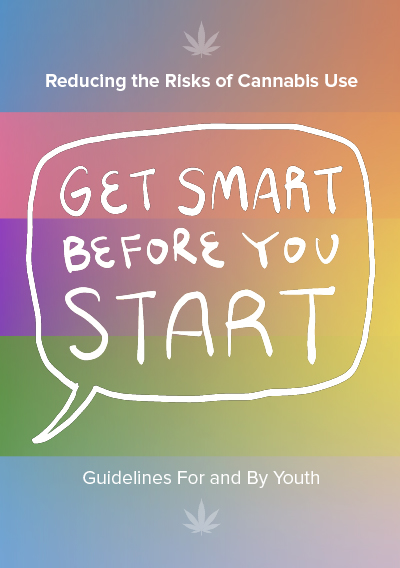Using guidelines co-created for youth, by youth to lower the risks of cannabis use
Reprinted from the The Vibes Are Off: Young People, Anxiety and Depression issue of Visions Journal, 2025, 21 (1), pp. 25-27

Cannabis use is legal in British Columbia for adults over the age of 19 and illegal for underage youth. Despite efforts to encourage youth to avoid using cannabis, Canadian data shows youth under the age of 25 use it the most.1, 2
While cannabis use is increasingly accepted among adults in our country, youth cannabis use remains taboo. Parents and caregivers often struggle with how to talk to the young people in their lives about this substance.
We hope to support caregivers with a new zine that might help adults initiate conversations around cannabis with young people. The zine was created for youth, by youth as part of an ongoing research project aimed at providing youth who choose to use cannabis with strategies for safe use.3 We extend this new tool to parents and caregivers as an invitation to begin a caring conversation about youth cannabis use.
Creating a caring resource for youth, by youth
In 2021 our research team at the Canadian Institute for Substance Use Research responded to the need for more accessible, youth-oriented cannabis harm reduction resources. To better understand what key components should be in an accessible guide, we worked with a Cannabis Youth Working Group (CYWG).
The CYWG included seven young people in BC aged 16 to 25 who’d previously used cannabis. The youth came from different walks of life. Five identified as cis women, four identified as belonging to a sexual minority (i.e., non-heterosexual) and five had current or past mental health challenges. Due to COVID-19 restrictions, meetings were held online.
Together, we undertook a review of the research literature and in 2022 conducted a survey of 230 Canadian youth ages 16 to 24 to learn about their experiences with cannabis. The research team also interviewed the CYWG about their reasons for using cannabis, how the substance related to challenges in their lives and the connections between cannabis and their mental health.
We found that youth had both positive and negative things to say about how cannabis influenced their mental health. Some youth felt cannabis shaped their mental health in a good way—for instance, helping to deal with their underlying mental health concerns, such as anxiety and depression. Other positive connections included that cannabis helped some youth cope with trauma or prevented them from using or relying on other substances.
Still, some youth shared negative experiences, including how cannabis made their anxiety and depression worse. Some additionally shared how cannabis negatively affected their social connections. Youth explained how their relationship to cannabis ebbed and flowed depending on where they were, who they were with and their life stage.
Overall, youths’ experiences fluctuated along a spectrum of “good, bad, and it depends”—it was never black and white. The young people we surveyed were aware of the individual effects of their cannabis use, especially when they noticed it was becoming harmful or was no longer useful to them.
Lowering the risks of using cannabis
Based on these findings, we worked with the CYWG to co-create six guidelines for how youth can lower the risks and maximize the benefits of cannabis use. The Guidelines are:
- Get educated before you use and continue to educate yourself
- Reflect on why you’re using cannabis and pay attention to how it affects you
- It’s OK to wait until you’re older or to not use cannabis at all
- Start low, go slow
- Consider where you are and who you’re with
- Consider what you’re using and how you’re using it
In 2024 our research team began the project’s second phase, this time focusing on creating a resource that would make the draft guidelines more accessible to youth. We gathered a second CYWG to advise us on how to increase accessibility.
They suggested that we first make some adjustments to the original guidelines—specifically, we needed to use more affirmative language and encourage more self-reflection. Once the CYWG was satisfied with these refinements, we brought in a user experience designer to transform the guidelines into two posters and a zine that encourage young people to become more knowledgeable about cannabis, whether for themselves or others in their community.
Recommendations for parents and caregivers
The second CYWG shared some recommendations for parents, caregivers and other adults in their communities to consider when they decide to initiate conversations about cannabis with youth in their lives. Parents and caregivers can:
- Meet young people where they are at with consideration and friendliness
- Listen to and empower youth—it’s not about youth NOT using cannabis or behaving in a specific way
- Understand that youth deserve to be well supported even when they aren’t acting in the ways you think they should be
- Be part of breaking the stigma around youth using cannabis
- Recognize that youth can still be hard workers even if they’re using cannabis
- Make it safer to have challenging conversations
We hope the Cannabis Zine will help parents and caregivers incorporate words of affirmation into their toolbox when cultivating spaces for caring conversations with the young people in their lives.
Caregivers can think of the zine as an invitation to see the world from young people’s perspectives and to reflect on the words they choose to express empathy and non-judgment towards other youth in their communities.

Access the zine and learn more about youth-led work to reduce risks of cannabis use at our project website: chirp.uvic.ca/lrcug.
Did You Know?Did you know young people have the highest rates of mental health and substance use challenges compared to any other age group? Despite this, they tell us: - There are not enough youth-oriented health and social services - They sometimes avoid services altogether for fear of being judged or stigmatized - They sometimes avoid accessing mental health services to prevent their parents or caregivers from finding out (Facts drawn from: McGorry, P. D., et al. (2022); Gulliver, A., et al. (2010); and Smith, A., et al. (2024) |
About the author
Andrea is a post-doctoral fellow at the Canadian Institute of Substance Use Research (CISUR), University of Victoria (UVic). Her research aims to better understand what caring, safe and non-judgmental health and social services look like from the perspectives of youth who seek to access them
Cecilia is a sociologist and scientist at CISUR, UVic. Her research advances health care and social rights for Canadians who are structurally marginalized due to factors beyond their control, including youth in transition to adulthood
Footnotes:
-
Health Canada. (2023). What we heard: Improving access to drugs and other health products in Canada. canada.ca/content/dam/hc-sc/documents/services/drugs-health-products/drug-products/drug-shortages/what-we-heard-report/what-we-heard-report.pdf
-
Kourgiantakis, T., Vicknarajah, R., Logan, J., Edwards, T., Lee, E., Craig, S., Kaura, A., Williams, C. C., & Marshall, S. (2024). Understanding youth and young adult cannabis use in Canada post-legalization: A scoping review on a public health issue. Substance Abuse Treatment, Prevention, and Policy, 19(30), 1–24.
-
Card, K. G., Koenig, B., Moebes, Z., Muratov, M., Jansson, M., Selfridge, M., Korol, K., & Benoit, C. M. (2023). Lower risk cannabis use guidelines for youth, by youth. uvic.ca/research/centres/cisur/assets/docs/youth-cannabis-guidelines.pdf
